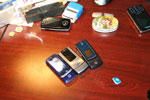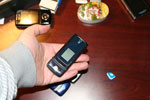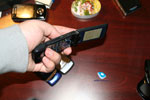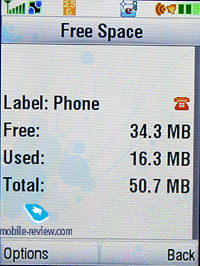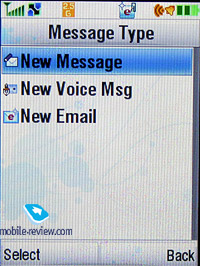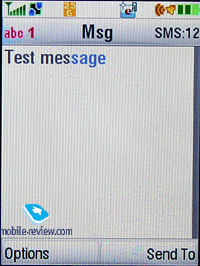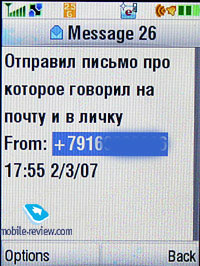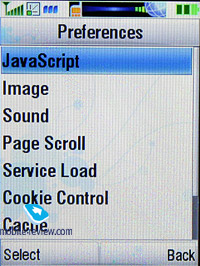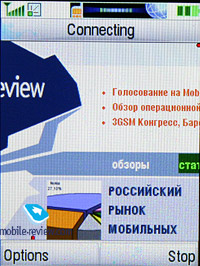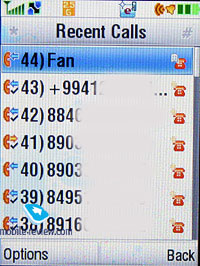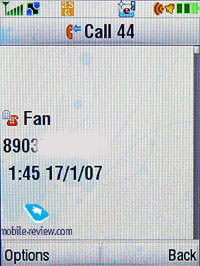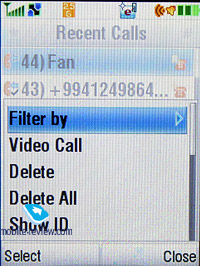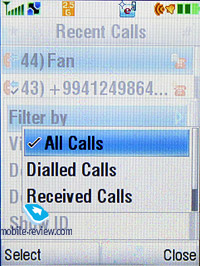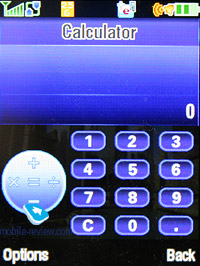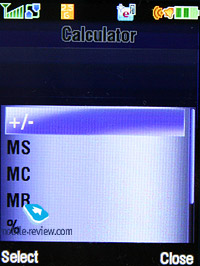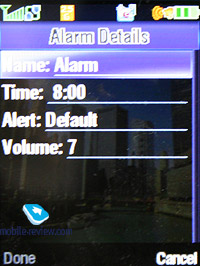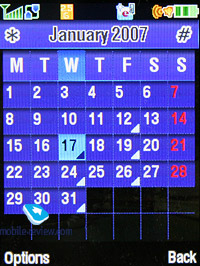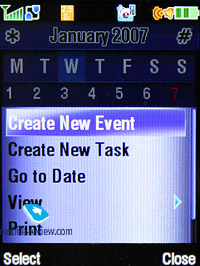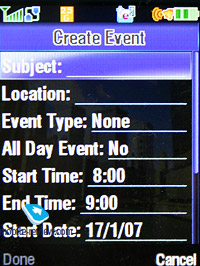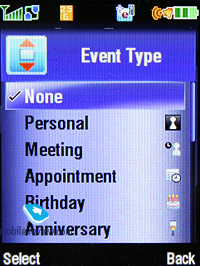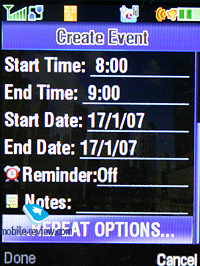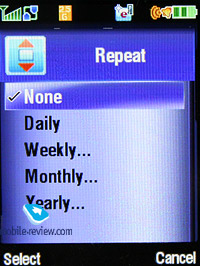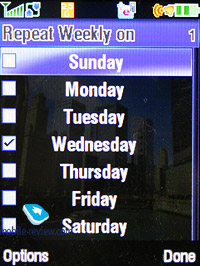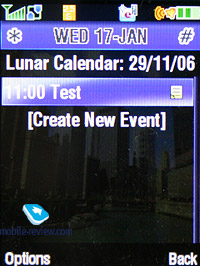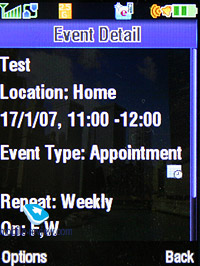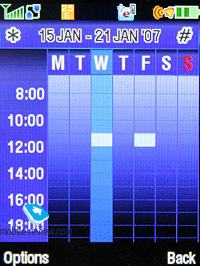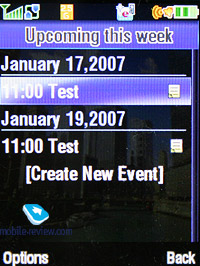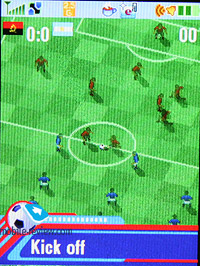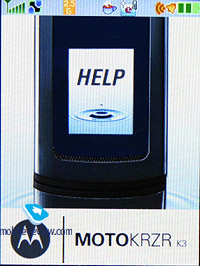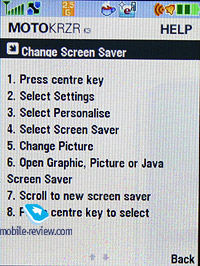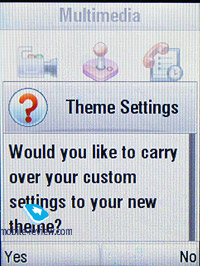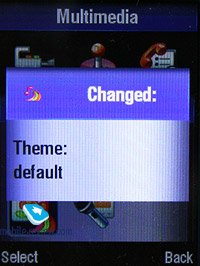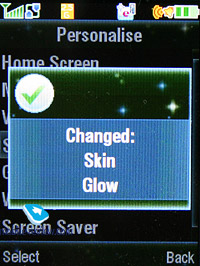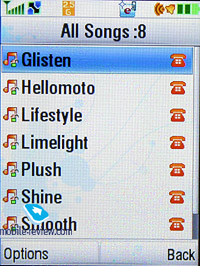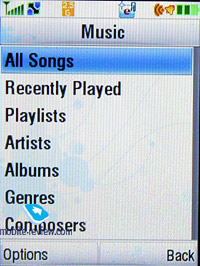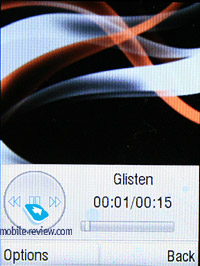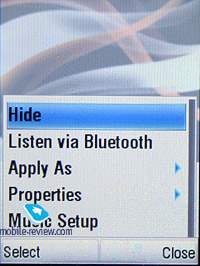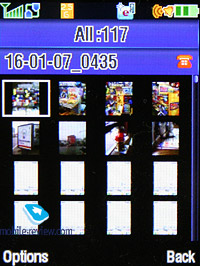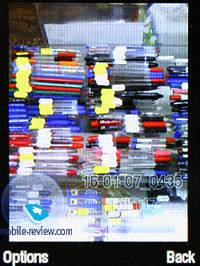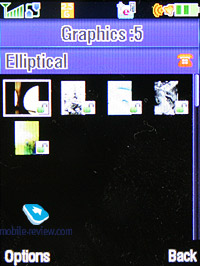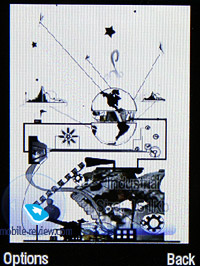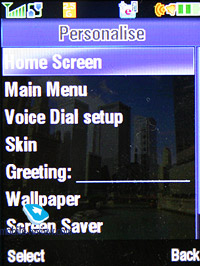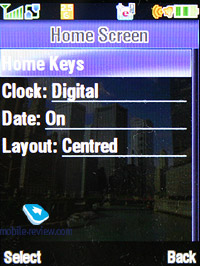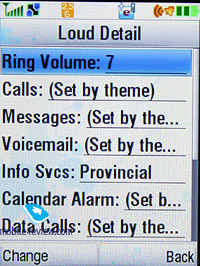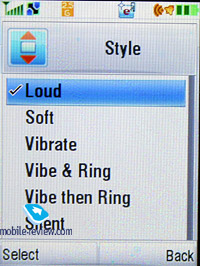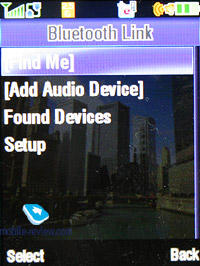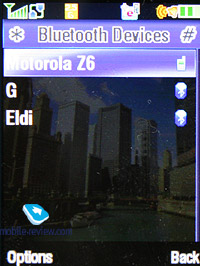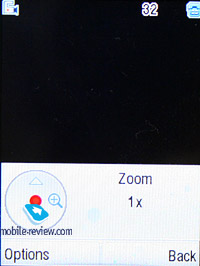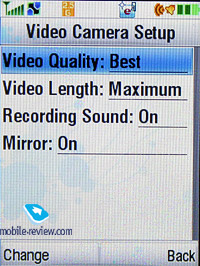|
|
Review of GSM/UMTS-handset Motorola K3
Live photos of Motorola K3
Sales package:
- Handset
- Battery
- Charger
- Wired stereo-headset with call answer key
- USB data cable
- CD with Mobile Phone Tools
- Memory card (size and availability vary by region, for Russia there is no memory card included)
- User Guide
Motorola is really getting into launching copycats of its own products – one shouldn’t go too far to get an example, as Motorola Z3 and the Z6 sported totally different software, albeit they possessed identical casings. Motorola K3 adopts the shapes and curves of the line-up’s first offering, specifically Motorola K1 KRZR, though due to its bigger external display looks somewhat different. It was interesting to see how my colleague, who had always been calm towards this company’s solution, got a sparkle in his eyes when he saw this particular device. At that the design of the K3 has remained almost the same, with the materials used being our only item on to-note list. If back in 2004 the company was setting off to apply metal in casings and expose its usage in every last way, then in 2006 they switched to mirror-like coatings, the combination of glass and plastic, like we saw it in the KRZR. The new trend for 2007 – metal disguised with chrome-plated surfaces and the attempts to get the products make a statement of their status with their looks alone. Remember Motorola Z6, as this handset perfectly fits into this concept – it has chrome finish on and looks like Nokia 8800. In many respects the efforts of the designers are aimed to deliver similar feel, set up a base for positioning in a more expensive market segment, where the models’ exteriors are properly finished.
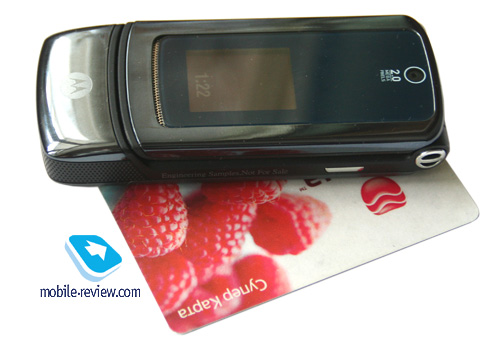
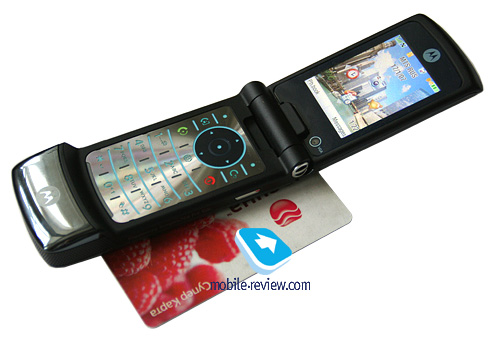
The K3 comes in two color schemes -– Dark Pearl Grey and also Stone Grey. Both look fetching.

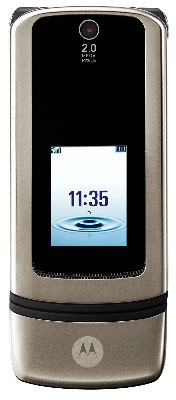
The handset’s surface is not prone to grease, being chrome-plated shot with blue steel. The metal grill of the external speaker, placed underneath the display, contributes to the overall impression. The bottom part of the casing is traditionally made plastic for it is the place where the antenna sits. Looking at the central part, you will definitely see a dark-painted inset that goes well with the rest of the casing. The rear surface is matt, as here the metal is coated in something similar to soft-touch finish, though it doesn’t affect the tactile experience much.

The phone measures up at 103x42x16 mm and weighs in at 105 grams (which is 2 grams on top of the K1’s weight). These dimensions are comfortable enough to allow you to carry the handset in any way you like. On the fashion front, it everything but a runner-up when faced off against the previous offerings, even though it is not that flashy, it has some latent charm of its own. To me, the handset is more like exceptional, yet staid things. This handset will suit both a businessman and a fashion-conscious consumer. Whereas Motorola K1 reminds more of a Christmas-tree toy, the K3 doesn’t suffer from that and what’s more, benefits from this by being less smudge-prone.

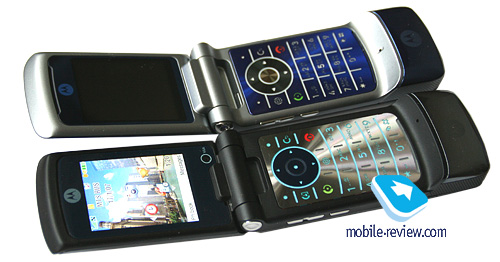
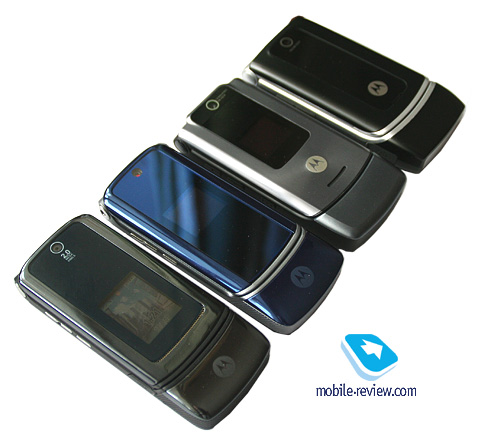
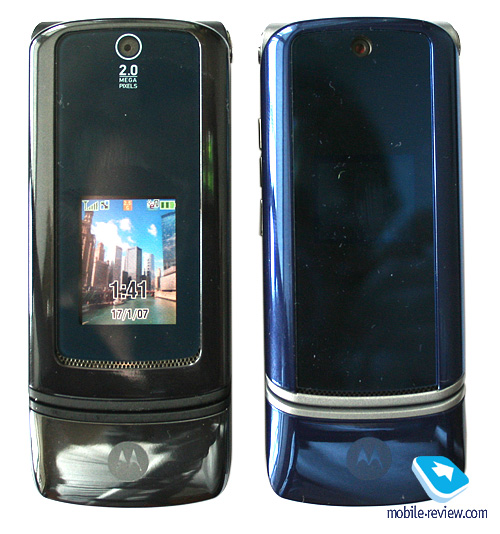
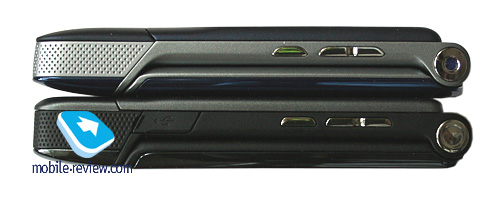
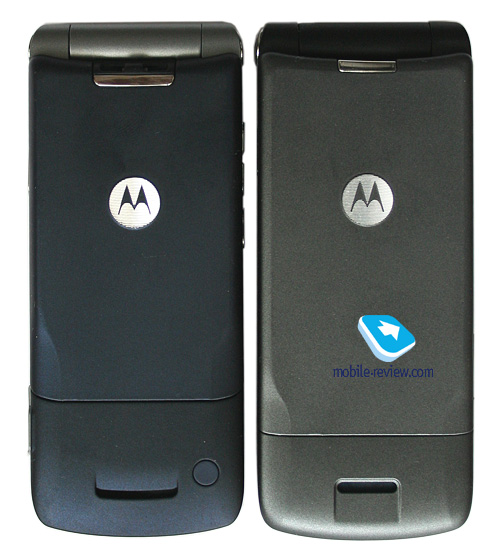
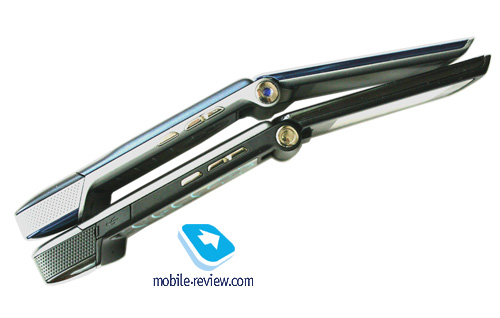
Big outer display is getting to be another trait of Motorola-branded solutions; the impending models will sport even bigger size and resolution of their external screens (we are talking solely about prime products). The K3’s TFT-powered unit shows up to 65 K colors and boasts a resolution of 120x160 pixels (20x26 mm). While in standby mode, it falls into inversion mode, displaying only the clock, but when a call comes in, the screen comes back to life, showing a full-size picture, which is a really good thing. On the upside, the picture on the outer display looks good at the standby screen, even though the backlighting is not particularly bright (which helps to deal with direct sunlight, though only partly and on certain occasions). Generally speaking, for outdoors use this screen is competent enough, however in the sun it gets washed out after all. The display’s capabilities are used not to the limit, but this will be the next step for the developers. Unlike Cover UI found in Nokia-branded devices, where you can read messages and do a lot of other things without opening the phone, the K3’s display, offering resolution like this, can only put on caller ID and change profiles, without enabling you to read a message, although the resolution would be just right for that purpose.
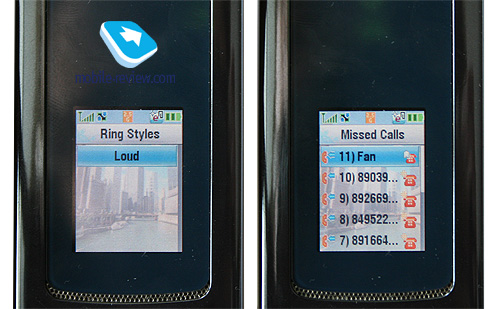
On top of the display sits the lens of the 2 Mpix CMOS-camera. The left side retains the volume rocker, and right underneath – Smart-key. The user is at liberty to customize it and assign to Camera app or something else. While navigating through the menus, this key may double as OK-button or act in a different way, depending on the given menu item. On the right spine you will find Voice Command key standing for voice dial, voice commands in a standby mode and voice recorder activation during a call. The MiniUSB slot for plugging in charger or headset is also embedded in the side plate.
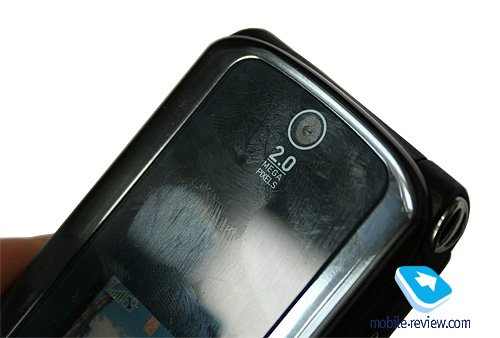

Flicking the KRZR open single-handedly is really easy. Flip-open, it measures 17.5 cm in length, which fits any man or woman, even with a large head. The earpiece is covered with a metal grill; the display’s edging matches the exterior inset color-wise. Right beneath the inner screen is the VGA-camera used for videoconferencing within 3G netwoks.
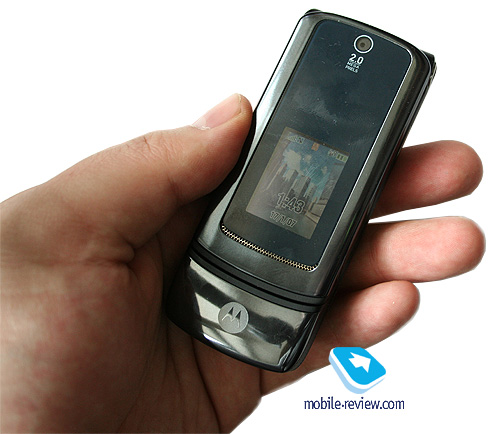
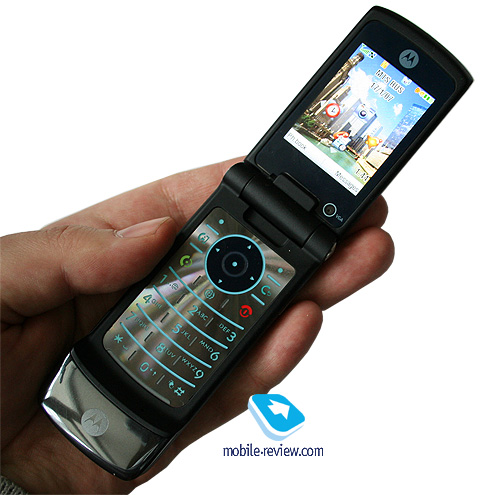
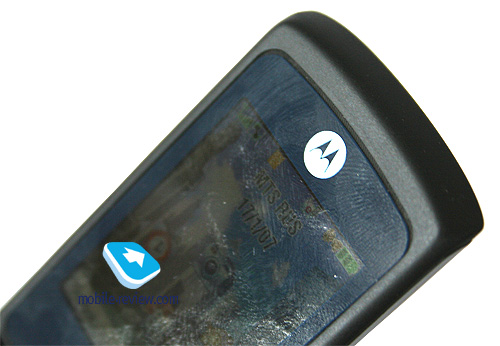
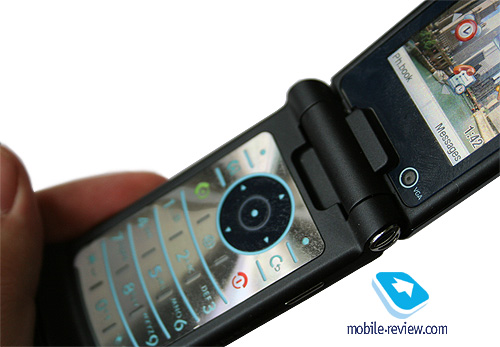
This display is no different from that found in Motorola K1 (its European edition, not the K1m) and offers a resolution of 240x320 pixels (31x41 mm, 2 inches) and shows up to 262 K colors. The screen’s quality is superb with its contrast and crisp picture, while relatively small diagonal makes all details appear very sharp. The display accommodates up to 6 text and 3 services lines. The K3 can be easily used in the sun, thanks to TFT technology its internal display employs.
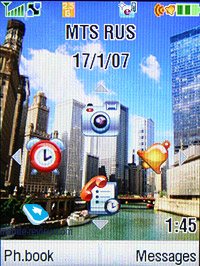
The K3 seemingly retains a RAZR-esque keypad, but on closer examination turns out to be a replica of that in the RAZR V3xy. The buttons are equipped with rubberized ridges, making for a better handling experience. The good thing about the buttons is that they have fairly admirable feedback – the keypad doesn’t feel flat. All keys are evenly lit in dim blue.
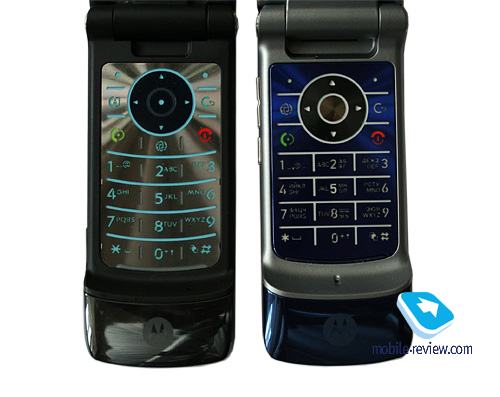
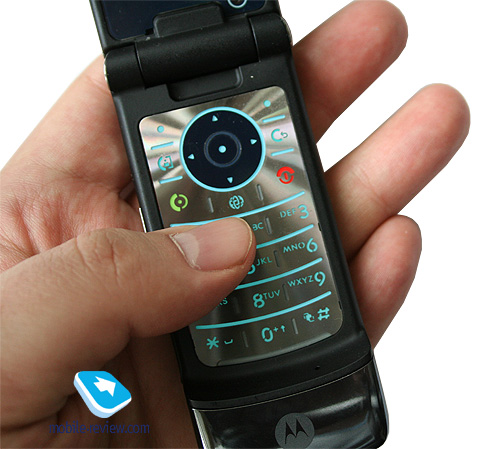
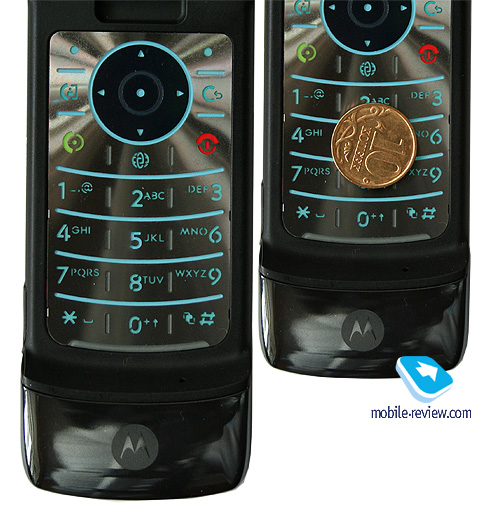
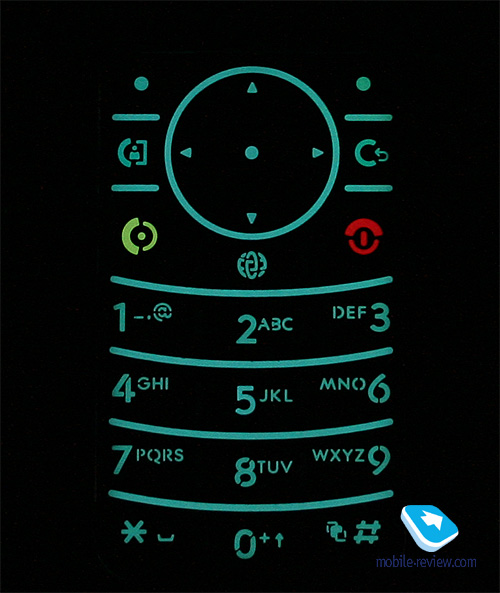
Large rubberized pad placed beneath the keyboard is meant for preventing the display from touching the keypad. However nothing like that does happen – if you let the internal screen get soiled, you will surely notice the keypad-print on it. Generally speaking, the same holds true for other models coming from the RAZR range.
The back cover has no gap, and hides the BT50 underneath, which is a 700 mAh Li-Ion battery. As the manufacturer claims the KRZR manages to provide talk and stand-by times of up to 6 and 300 hours respectively on a single full charge. In conditions of Moscow networks the device remained good for 2 days on average at 1 hour of calls, up to 20 minutes of the other functions use and 1 hour of music playback. There aren’t any more-capacious batteries available for the device. Anyway, it would be hard to squeeze something more out of the K3, as two days is a quite OK lifetime. It takes the handset 2 hours to charge from empty to full.
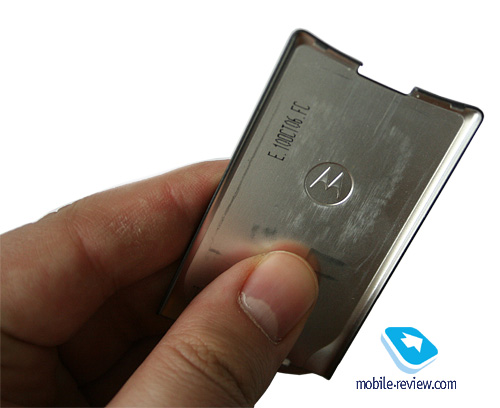
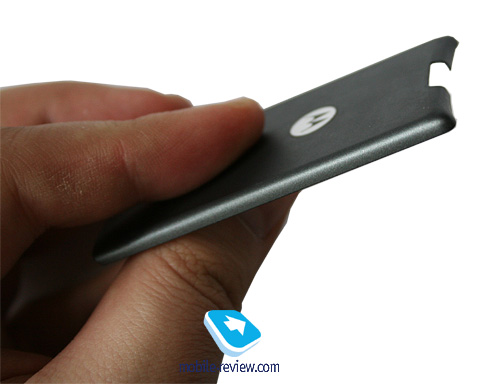
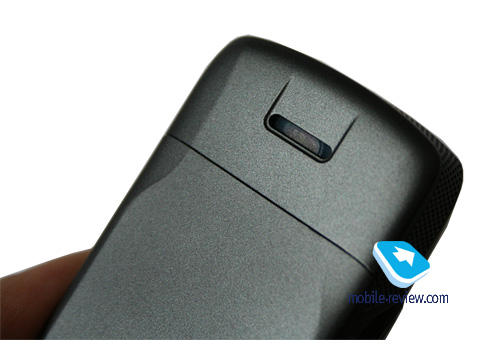
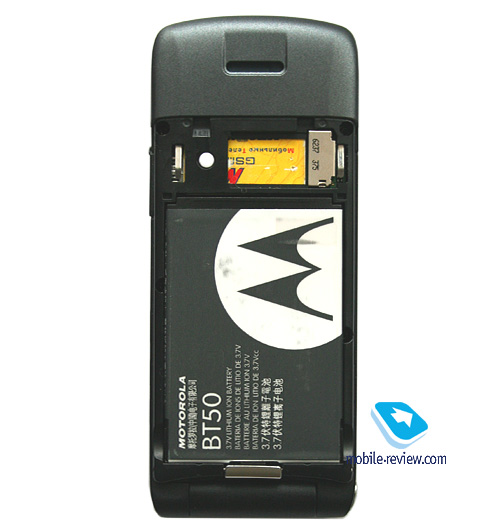
The SIM-card can be installed only when the battery is detached, while microSD card has hot swap enabled, but as you might have already guessed, the back cover must me taken off prior to swapping cards.
Menu
The handset houses 21 Mb of user-manageable memory, this volume can be expanded with a memory card, where you can keep various applications on. An executable Java file is restricted to 1MB in size (the size of a JAR-file), while the HEAP can top out at 2MB. Actually which memory type is used doesn't matter to the phone when working with files (music, calls, photos, applications). The phone will easily play back files with 256 kbps or an alternating bitrate perfectly; problems pop up on rare occasion only for some specific tracks.
Memory for applications is distributed dynamically, 1000 contacts is an assured number of entries that can be saved in the phonebook. The organizer can store up to 500 events and 400 tasks (or any combination of these that doesn’t exceed 900). An MMS is permanently limited by 300 KB in size.
You can access the Main Menu by pressing the OK button. The main menu traditionally features 12 icons; each of them uses information bar at the display’s top for captions. You can switch the appearance of the main menu to the list mode and then everything will get arranged in plain lists. A half of the submenus is represented as lists and another half as icons (if you choose a corresponding menu appearance). There is no shortcut number navigation in the menu, though you can setup shortcuts for almost every menu item or function (including custom apps). For standby mode, the navigation key may call up various applications that are assigned by the user. Furthermore, you can play around with the options in order to make all icons disappear from the screen until the navi-pad is pressed. Two soft-keys can be bound to various actions as well, apart from the default ones. With such menu flexibility at your disposal the lack of the shortcut number navigation is not that crucial.
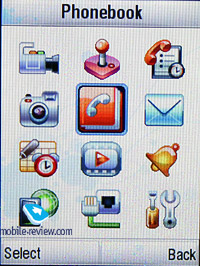
The device supports iTap-powered predictive text input. While typing, the screen displays submitted words, but hides symbols assigned to the keys.The device memorizes the variants of the words you picked and after that offers them automatically. That helps to avoid entering words into the dictionary as in case with the T9.
Those using two languages for typing SMS messages will be happy to find out that this option is very manageable on the MAXX. You can also setup which type of text input to use for every language - predictive or not. An interesting solution that extends possibilities for customization of your mobile phone even further. However, I would like to notice that only a small number of people use more than two languages.
Software-wise the K3 follows in the footsteps of RAZR V6 Maxx and Motorola K1; in fact it adopts specific features of both handsets.
Phonebook. Not less than 1000 names can be saved in the phone's memory and for each entry you can store First Name and Last Name (two fields), Nickname, phone number (select its type in a list - home, work, mobile, fax and so on, available for videocalls or not). At entering a number you will get only one field, but be sure another one will get highlighted after you fill the given field. That means the phone offers step by step data entry, which seems quite logical. And the last but not the least, up to 7 numbers can be kept for a single contact, which is enough for the majority of users.
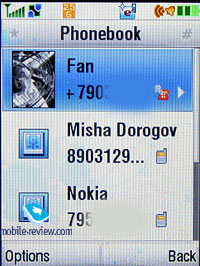 
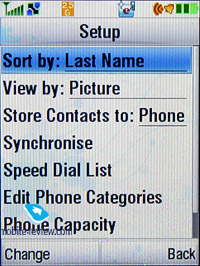 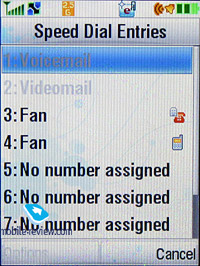
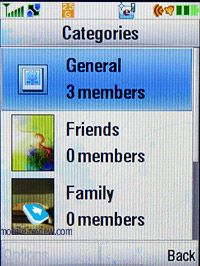 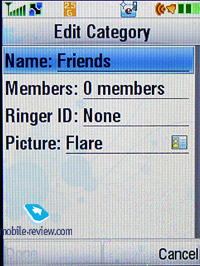
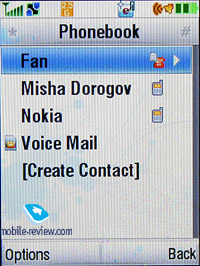 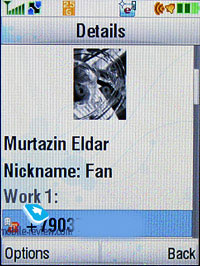
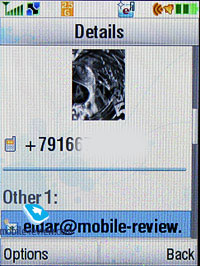 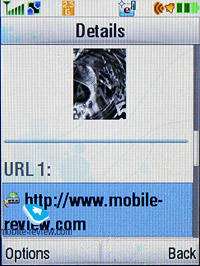
 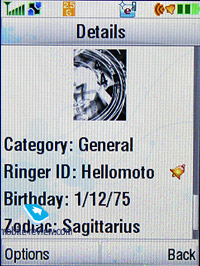
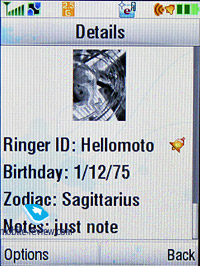 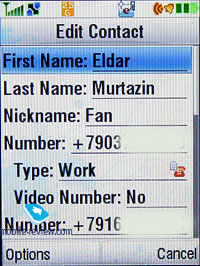
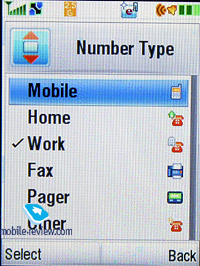 
Apart from telephone numbers you can enter e-mail addresses (up to 2), URL, a postal address (two fields for street, city, state, area code, country). Also we should mention a text note, a personal ring tone, user groups (unlimited number, and each one can have a personal tune), and a birthday. Unfortunately, no reminder on birthday is scribed in the organizer automatically, no sound signals appear either. I consider it to be the next step in development of the phonebook.
The handset makes use of a speaker-independent voice recognition system, which means no voice tags are required (though they vary by region and selected menu language) – you can dial any contact or call up applications with voice right away.
The general list shows names both from the phone memory and SIM (only one type is viewable at once). Search may be carried out by several letters and you can add until a word is complete. Three view modes of the list are available - only names with an icon of a default number; names and photos and the first phone number (a default one); names with a number. Fast scrolling with the help of horizontal presses is enabled on the K3. Any number can be added to the fast dial list, so that you can send a message or call a selected number via a pop-up menu.
The groups settings enable you to pick personal ring tones and images for them – the MAXX houses 4 groups by default, though this number can be easily extended by user. Support for mass message sending to group members is onboard.
A really apt addition to the interface is filter by e-mail address (sorting of the general list) or recently used numbers (works for SMS as well) – in the latter case the list is topped by Recent Contacts.
You can retrieve contacts from other phones, which is an attractive capability. And if names coincide, two entries are created. If one of the entries has a Nickname field filled up, then the contact will be displayed under this nickname, rather than under the First Name and Last Name. In fact this is one of the first devices that can receive complete information on contact from another device (for example contacts beamed from Sony Ericsson K800i had assigned photos on the K3).
Synchronization with MS Outlook brings about no problems
Messaging. The handset’s memory is distributed among message banks dynamically, most firmware versions for this handset allow saving not less than 400 messages (in various folders). The device can handle EMS if such necessity arises. Automatic cleaning of the whole message list should be mentioned as an extra possibility, as well as a list of templates. Delivery report may be turned on permanently or switched on/off for a given message.
MMS management doesn't cause any inconvenience; everything is quite straightforward. Messages can be enhanced with pictures taken with the built-in camera and sound clips. The ten predefined templates, similar to those found in the previous models, are really great; make sure you check them out.
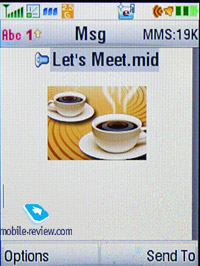 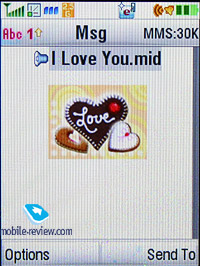
The phone has POP3/IMAP4 e-mail client, allowing watching the headers of the incoming mail and downloading their contents as well (modes: retrieve only header, header and message body, full message). You can set up scheduled mail check, so that the K3 would update the mail box at regular intervals, ranging from 15 to 24 hours. Only images, video, mp3 that do not exceed a certain size limit can be sent. Any attempt to save a file with unrecognized extension will end up a failure. Which is a shame, since all received files can be transferred to PC. It is also not possible to upload attachments shown in the headers – first you will need to retrieve the message body and only then all attachments you need. In case you want to store some of the e-mails, you will have to use the dynamically spread memory, just like in case with MMS.
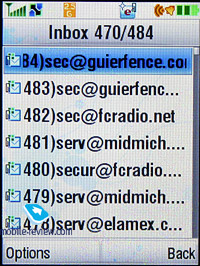 
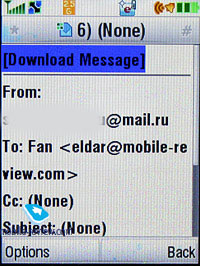 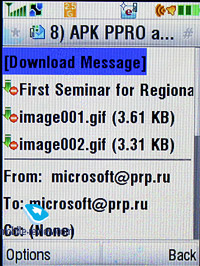
Opera 8 is the default browser, sporting cookie support, ability to fit viewed pages into the screen (and also full-screen mode), font settings, dynamic scaling, Javascript and loads of other options to choose from or adjust. The browser handles Russian encodings with ease – if we are to face off Opera 8 against other offerings, it does pretty good. The browser version for such device is far inferior to Opera 8.5 in terms of capabilities – for example the 8.5 is bundled in Motorola Z6.
Recent calls. The handset retains a merged list of calls, which means there you will find both missed and dialed numbers. Special lists for 40 recent calls are also available. Not only the caller's name but the type of the number is shown, if it is kept in the phonebook. Everything is rather simple and traditional, nothing special at all. Each entry features the date and time as well as the duration.
Also this menu shows last calls, call duration and data connections.
Tools. This menu features a whole bunch of office applications such as the Calculator. It's convenient; the full digital keyboard is present on the screen, which reproduces the real keyboard perfectly. The menu features memory options and the currency converter.
Alarm clock. You can set up several alarm clocks, choose custom ring tones, name and volume, type of reoccurrence (daily, single time) for each of them. This phone was designed for continuous use, that's why entering names and titles for the alarm clocks is required. Alarm clocks are activated in one touch, and a note really makes handling alarms a breeze.
Voice recorder. The recording function can be called up both in standby mode and while calling – in the latter case it records both sides. Maximum duration of a recording is limited only to amount of free space you have on your K3. Your interlocutor gets notified if the voice recorder has been started – at first it’s a buzzing sound and then short peeps at regular intervals.
Organizer. You can view it monthly or weekly with breakdown for hours. You will see your appointments bound to a certain time of the day, it's convenient. Each entry can be assigned with a name, start time, length (measured in hours, the minimal amount of time - 30 minutes). Alert can be set up to trigger off before the event (user-manageable). Each entry can set to be recurrent, which is a major attraction. The calendar also holds to-do list, where every task can have priority, due date and status, regrettably this is not a stand-alone item.
SyncML support is enabled on the K3, which is aimed at enterprise users who are in great need of synchronization with data server (a kind of remote synchronization with Desktop PC, but this time the server must be located in the network).
Activation List – the handset boasts support for DRM 2.0, so that in the Activation list you can check out licenses, their status etc.
Games and applications. The phone supports Java MIDP 2.0; all applications that are located in this menu item are based on this technology. The number of games and their title depends on where the phone was bought. In most cases you will end up having only Sudoku and Football onboard.
From this point on, the Applications menu holds K1 Help items, which is a kind of guide to the device’s main features.
Multimedia. The phone supports themes. It's a set of wallpapers, color schemes for the menu, sounds and ring tone types. You can change the outlook of your phone almost instantly and this is really amusing. New themes can be downloaded from Motorola's website.
The number of available skins has been modified and now they look differently as well. They not only change menu color, but the windows as well as the rest of the interface, which is quite nice thing to play around with.
Sounds - information about all sound files stored in the phone's memory is located here. You can check out their size, info and even listen to them. The player found on the Z3 is similar to other Motorola's phones; everything is clear and straightforward. The great advantage of this very player is playing back mp3's in background mode. You can compose you own play lists with the help of corresponding tools. Flipping the handset closed you will see that the track list is shown on the outer display and is very manageable with the help of the side-mounted keys and the Smart-button, which is handy. Support for MP3, as well as AAC and AAC+ is onboard.
Pictures - list of all images located in the phone's memory. There's a special icon placed next to each file. Every picture can be set as the wallpaper or screensaver. Pictures can be sorted by categories; which makes browsing easier.
Moreover, you can use a built-in editor, which allows overlaying frames, changing color scheme and using special effects. The most convenient part is that after editing a picture it can be stored with a new name. This means that both the original and the new picture will be available for use. This may come in handy in case you want to edit the photo, and not to ruin the original.
Settings. Here you can setup all Display settings including the color schemes.
Ring tone type and notification mode (mixed mode, when the silent alert goes off at the same time with the ring tone) is here as well.
Here you can activate the Flight mode and set an alert on its activation. The fact that profiles are missing on the K3 frustrates a little, however the Flight mode is the first step towards fully-functional profiles.
Security settings. Now you can protect some functions with a password – be it the phonebook, messages, or some other phone’s sections.
Bluetooth settings haven’t changed at all; with the Print option available, printing is possible for a message, an organizer note or a phonebook entry
The supported standard is 1.2; apart from the Print profile the handset now can provide Audio Profile (A2DP), which allows pairing up a stereo headset with it. You can't use fast forward feature from the headset; however it will certainly help you to switch tracks. Bluetooth data transfer speed tops out at nearly 25-30 Kb/s.
Camera. With an integrated 2 Mpix CMOS module you can take photos of four resolutions - Large (2MP), Medium (1.2 MP), Small (480x640), X-Small (240x320). Three grades of compression are available. Other settings allow turning off the shutter sound, exposition from -2 to +2, selecting a lighting type (auto, sunny, cloudy, indoors, office). Self-timer feature is also enabled.
Best results are achieved in bright sun light, whereas in other cases color saturation is far from sufficient. A fetching trait is that a photo is shown in full-screen mode when managing with the camera, while the tips are semitransparent. You can change lighting settings with vertical declinations of the navigation button, as well as select various effects (color, black and white, blue, old-like, red, green, and negative). Digital zoom (up to x8) is also at your disposal.
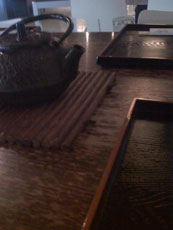 |
 |
(+)
maximize, 1200x1600, JPEG |
(+)
maximize, 1200x1600, JPEG |
 |
 |
(+)
maximize, 1200x1600, JPEG |
(+)
maximize, 1200x1600, JPEG |
 |
 |
(+)
maximize, 1200x1600, JPEG |
(+)
maximize, 1200x1600, JPEG |
 |
 |
(+)
maximize, 1200x1600, JPEG |
(+)
maximize, 1200x1600, JPEG |
 |
 |
(+)
maximize, 1200x1600, JPEG |
(+)
maximize, 1200x1600, JPEG |
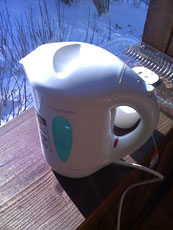 |
 |
(+)
maximize, 1200x1600, JPEG |
(+)
maximize, 1200x1600, JPEG |
 |
 |
(+)
maximize, 1200x1600, JPEG |
(+)
maximize, 1200x1600, JPEG |
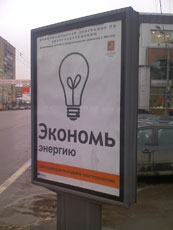 |
 |
(+)
maximize, 1200x1600, JPEG |
(+)
maximize, 1200x1600, JPEG |
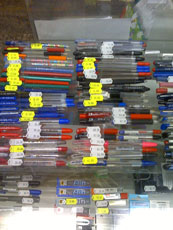 |
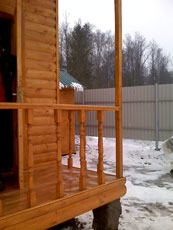 |
(+)
maximize, 1200x1600, JPEG |
(+)
maximize, 1200x1600, JPEG |
 |
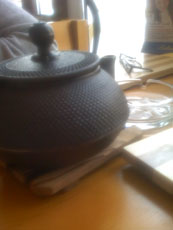 |
(+)
maximize, 1200x1600, JPEG |
(+)
maximize, 1200x1600, JPEG |
You can select video quality - good, better and the best. Maximum clip duration is unlimited. And it is curious that the interface for still images differs from the video capturing mode and calls up another menu item. You can change the settings quickly, however the picture takes only a part of the screen, there is only one resolution available - 176x144 pixels. Video quality is average; sound recording can be disabled for any given video clip. All clips are recorded at 15 frames per second.
Video sample1 (3gp, 404 Kb)>>>
Video sample 2 (3gp, 250 Kb)>>>
Performance. Unlike the K1, this model puts up average numbers for its class and obviously comes out on top compared to the predecessor. Though it does break break significant new ground.

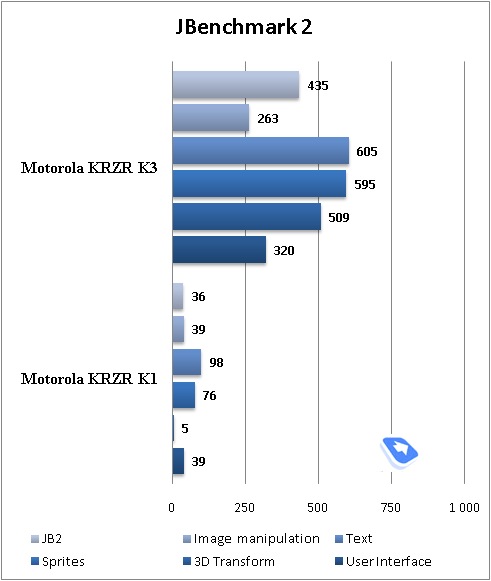
| Jbenchmark 3D |
Jbenchmark HD |
| Perfomance |
|
| Jbenchmark3D HQ: |
402 |
| Jbenchmark3D LQ: |
426 |
| Triangles ps: |
50770 |
| kTexes ps: |
4819 |
|
|
| version: |
3.1.0 |
|
|
| Screen(canvas)width: |
240 |
| Screen(canvas)height: |
300 |
|
|
| 3D Subsystem: |
|
| M3G Version: |
1 |
| Antialaising: |
false |
| True color: |
false |
| Dithering: |
false |
| Mipmapping: |
false |
| Perspective correction: |
true |
| Local camera lighting: |
true |
| Max lights: |
256 |
| Max Viewport dimensions: |
1024 |
| Max Texture Dimensions: |
1024 |
| Max Sprite Crop Dimensions: |
1024 |
| Max Transforms Per Vertex: |
2 |
| Number of Texture Units: |
2 |
|
|
| Other properties |
|
| Color Screen |
true |
| Number of colors |
65536 |
| Transparency (alpha level) |
4 |
| Double buffer |
true |
| Total memory: |
3936220 |
| Free memory: |
3023684 |
|
|
| MicroEdition Configuration |
CLDC-1.1 |
| MicroEdition Profiles: |
MIDP 2.0 |
| Microedition Platform: |
j2me |
| Microedition Encoding: |
ISO-8859-1 |
| Microedition Locale |
en |
| Microedition Communication ports: |
COM0 |
| Microedition Hostname: |
none |
|
| Version |
4.0.3 |
|
|
| Rendering Quality |
|
| Bilinear filtering: |
63% |
| Trilinear Filtering: |
Failed/Not supported |
| Perspective correction: |
Failrule (64%) |
| Z-buffer depth: |
16 bit or higher |
|
|
| Perfomance |
|
| Smooth triangles: |
94395 |
| Textured triangles: |
68849 |
| Fill rate: |
1445 kTexels |
| Gaming: |
280 (9.3 fps) |
|
|
|
|
| 3D Subsystem: |
|
| M3G Version: |
1 |
| Antialaising: |
false |
| True color: |
false |
| Dithering: |
false |
| Mipmapping: |
false |
| Perspective correction: |
true |
| Local camera lighting: |
false |
| Max lights: |
256 |
| Max Viewport dimensions: |
1024 |
| Max Texture Dimensions: |
1024 |
| Max Sprite Crop Dimensions: |
1024 |
| Max Transforms Per Vertex: |
2 |
| Number of Texture Units: |
2 |
|
|
| Other properties |
|
|
|
|
|
|
|
|
|
|
|
|
|
|
|
| MicroEdition Configuration |
CLDC-1.1 |
| MicroEdition Profiles: |
MIDP 2.0 |
| CLDC (JSR 30, 139) |
1.1 |
| Encoding: |
ISO-8859-1 |
| Locale |
en |
| Total memory: |
4014116 |
| Free memory: |
3056332 |
| MIDP (JSR 37, 118, 271) |
2 |
| Form width: |
240 |
| Form height: |
233 |
| Canvas Width: |
240 |
| Canvas Height: |
267 |
| Fullcanvas Width: |
240 |
| Fullcanvas Height: |
300 |
| Canvas doublebuffered: |
true |
| Color: |
true |
| Colors: |
65536 |
| Alpha levels: |
4 |
|
|
| FC (JSR 75) |
1 |
| PIM (JSR 75) |
1 |
|
|
| Bluetooth (JSR 82) |
1 |
| Connected inquiry: |
false |
| Connected inquiry scan: |
false |
| Connected page: |
false |
| Connected page scan: |
false |
| Master switch: |
false |
| Connected inquiry scan: |
false |
|
|
| OBEX (JSR 82) |
|
| WMA (JSR 120, 205) |
2 |
| Smsc |
N/A |
|
|
| MMAPI (JSR 135) |
1.1 |
| Snapshots encodings: |
encoding=jpeg |
| Video capture: |
false |
| Video encodings: |
none |
| Streamable contents: |
none |
| Mixing: |
true |
| Recording: |
true |
| Audio encodings: |
amr |
| Audio capture: |
true |
|
|
| Web Parser (JSR 172): |
no |
| WEB RPC (JSR 172): |
no |
| SATSA (JSR 177): |
1 |
| Location (JSR 179) |
1 |
| SIP (JSR 180): |
no |
|
|
| JTWI (JSR 185) |
1 |
| CHAPI (JSR 211): |
no |
| SVG (JSR 226): |
no |
| AMMS (JSR 234): |
no |
| Global (JSR 234): |
no |
|
Synchronization with PC. A full version of Mobile Phone Tools version 4.x is included into the package (not for all markets – the packages for Russia lack this software). The program capabilities cover the needs of the majority of users: they include synchronization with MS Outlook, making reserve copies on a PC, copying photos, tunes, drawing up messages on the PC. ActiveSync Exchange support is also onboard, though only remote synchronization is provided (with a mainframe via network).
Impressions
The model delivers good reception quality, typical for all modern devices. Ring tones’ volume is slightly above average, midi-tunes are played back via 64-chord polyphony module, which ensures fairly great sounding. The silent alert is nothing special on the K3 – it’s somewhere between “average” and “slightly above average” strength-wise. The loudspeaker outputs enough volume during conversations for nearly all environments.
This is a 3G-enabled device with HSDPA support; however in some regions such connectivity options haven’t made their debuts yet. The huge outer display is a thing of note on the K3, as well as good materials used here and more quiet design, as compared to the KRZR. Functionality-wise, there is not much to talk about when facing off this model and the KRZR, yet there are some, Used as a music phone ,the K3 won’t provide you with any kind of groundbreaking experience – you can use custom headphones via an adapter and still get good volume level. This phone is due out in Russian in late April at the starting price of about 450 USD, which will then start its smooth way down. In Europe this handset will make its debut already in early April. All in all the K3 is worth the money, albeit it is completely identical to the KRZR design-wise. Apparently, it is not a flagship, yet a strong solution and fashion savvy above everything else.
Eldar Murtazin (eldar@mobile-review.com)
Translated by Oleg Kononosov (oleg.kononosov@mobile-review.com)
Published — 05 April 2007
Have something to add?! Write us... eldar@mobile-review.com
|
News:
[ 31-07 16:21 ]Sir Jony Ive: Apple Isn't In It For The Money
[ 31-07 13:34 ]Video: Nokia Designer Interviews
[ 31-07 13:10 ]RIM To Layoff 3,000 More Employees
[ 30-07 20:59 ]Video: iPhone 5 Housing Shown Off
[ 30-07 19:12 ]Android Fortunes Decline In U.S.
[ 25-07 16:18 ]Why Apple Is Suing Samsung?
[ 25-07 15:53 ]A Few Choice Quotes About Apple ... By Samsung
[ 23-07 20:25 ]Russian iOS Hacker Calls It A Day
[ 23-07 17:40 ]Video: It's Still Not Out, But Galaxy Note 10.1 Gets An Ad
[ 19-07 19:10 ]Another Loss For Nokia: $1 Billion Down In Q2
[ 19-07 17:22 ]British Judge Orders Apple To Run Ads Saying Samsung Did Not Copy Them
[ 19-07 16:57 ]iPhone 5 To Feature Nano-SIM Cards
[ 18-07 14:20 ]What The iPad Could Have Looked Like ...
[ 18-07 13:25 ]App Store Hack Is Still Going Strong Despite Apple's Best Efforts
[ 13-07 12:34 ]Infographic: The (Hypothetical) Sale Of RIM
[ 13-07 11:10 ]Video: iPhone Hacker Makes In-App Purchases Free
[ 12-07 19:50 ]iPhone 5 Images Leak Again
[ 12-07 17:51 ]Android Takes 50%+ Of U.S. And Europe
[ 11-07 16:02 ]Apple Involved In 60% Of Patent Suits
[ 11-07 13:14 ]Video: Kindle Fire Gets A Jelly Bean
Subscribe
|
